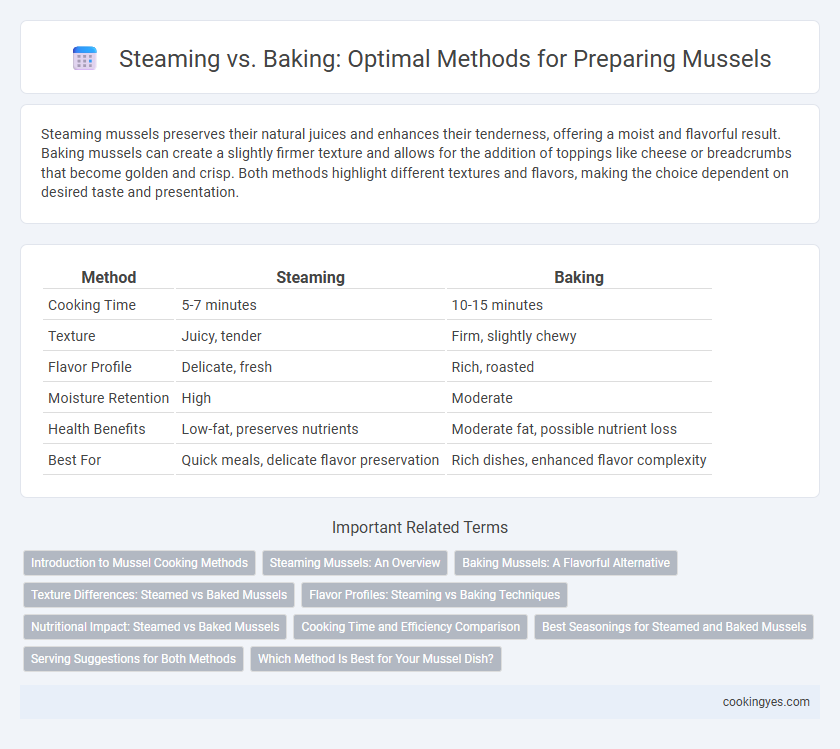Steaming mussels preserves their natural juices and enhances their tenderness, offering a moist and flavorful result. Baking mussels can create a slightly firmer texture and allows for the addition of toppings like cheese or breadcrumbs that become golden and crisp. Both methods highlight different textures and flavors, making the choice dependent on desired taste and presentation.
Table of Comparison
| Method | Steaming | Baking |
|---|---|---|
| Cooking Time | 5-7 minutes | 10-15 minutes |
| Texture | Juicy, tender | Firm, slightly chewy |
| Flavor Profile | Delicate, fresh | Rich, roasted |
| Moisture Retention | High | Moderate |
| Health Benefits | Low-fat, preserves nutrients | Moderate fat, possible nutrient loss |
| Best For | Quick meals, delicate flavor preservation | Rich dishes, enhanced flavor complexity |
Introduction to Mussel Cooking Methods
Steaming preserves the delicate texture and natural briny flavor of mussels by cooking them quickly in their own juices. Baking enhances mussels by infusing them with rich toppings or sauces, creating a more robust and layered taste experience. Both methods ensure mussels reach the ideal internal temperature of 145degF, ensuring safety while maximizing flavor.
Steaming Mussels: An Overview
Steaming mussels preserves their natural briny flavor and ensures even cooking by using moist heat confined in a covered pot. This method minimizes nutrient loss and enhances the tenderness of the mussel meat while allowing the shells to open naturally, signaling doneness. Steaming typically takes 5 to 7 minutes and can be flavored with aromatics like garlic, white wine, or herbs to infuse the mussels with subtle, complementary tastes.
Baking Mussels: A Flavorful Alternative
Baking mussels offers a flavorful alternative to steaming by infusing them with rich, savory toppings like garlic butter, herbs, and Parmesan cheese, enhancing their natural briny taste. This method creates a slightly crispy texture on the shell and a tender, juicy interior, perfect for gourmet presentations. Baking at 375degF (190degC) for 10-12 minutes ensures even cooking while preserving the mussels' freshness and depth of flavor.
Texture Differences: Steamed vs Baked Mussels
Steamed mussels retain a delicate, tender texture with a plump, juicy interior due to the gentle cooking method that preserves moisture. Baked mussels develop a firmer, chewier consistency as the dry heat causes water loss and a slight caramelization on the surface. Texture differences significantly impact the sensory experience, with steaming enhancing softness and baking introducing a more robust bite.
Flavor Profiles: Steaming vs Baking Techniques
Steaming mussels preserves their natural briny flavor and tender texture by gently cooking them in a moist environment that retains their juices. Baking mussels introduces a richer, slightly caramelized taste as the dry heat enhances the shellfish's sweetness and allows for crispy toppings like garlic butter or breadcrumbs. Both methods significantly influence the flavor profile, with steaming offering purity and freshness, while baking delivers depth and complexity.
Nutritional Impact: Steamed vs Baked Mussels
Steaming mussels preserves more water-soluble vitamins such as B12 and C, maintaining higher nutritional value compared to baking, which may cause some nutrient loss due to dry heat exposure. Steamed mussels retain more omega-3 fatty acids and minerals like zinc and iron, essential for immune function and oxygen transport. Baking mussels can enhance flavor but potentially decreases certain heat-sensitive nutrients, impacting overall nutritional density.
Cooking Time and Efficiency Comparison
Steaming mussels typically requires 5-7 minutes, retaining moisture and ensuring even heat distribution for optimal texture and flavor. Baking mussels takes longer, around 10-15 minutes, often resulting in a drier texture due to extended exposure to dry heat. Steaming offers greater efficiency with shorter cooking times and better preservation of mussel tenderness and juiciness.
Best Seasonings for Steamed and Baked Mussels
Steamed mussels benefit from light, aromatic seasonings such as garlic, white wine, lemon juice, and fresh herbs like parsley or thyme, which enhance their natural briny flavor without overpowering it. Baked mussels pair well with robust seasonings including garlic butter, Parmesan cheese, breadcrumbs, and spices like paprika or chili flakes, creating a rich, savory crust that complements the tender meat. Selecting seasonings based on cooking method highlights mussel texture differences, ensuring a flavorful experience whether steamed or baked.
Serving Suggestions for Both Methods
Steamed mussels retain a tender texture and are best served with a broth made from white wine, garlic, and herbs, perfect for soaking up with crusty bread. Baked mussels often develop a slightly firmer bite and pair well with melted cheese and breadcrumbs, enhancing their savory depth when served as an appetizer or part of a seafood platter. Both methods benefit from garnishes like chopped parsley and lemon wedges to elevate the fresh, briny flavors.
Which Method Is Best for Your Mussel Dish?
Steaming mussels preserves their natural briny flavor and tender texture by cooking them quickly in a small amount of liquid, making it ideal for dishes requiring delicate, juicy results. Baking mussels allows for a richer, more caramelized taste as the heat surrounds them evenly, often enhanced by toppings like garlic butter or cheese. Choosing between steaming and baking depends on whether you prefer a light, clean flavor or a savory, intensified mussel dish.
Steaming vs baking for mussel preparation Infographic

 cookingyes.com
cookingyes.com